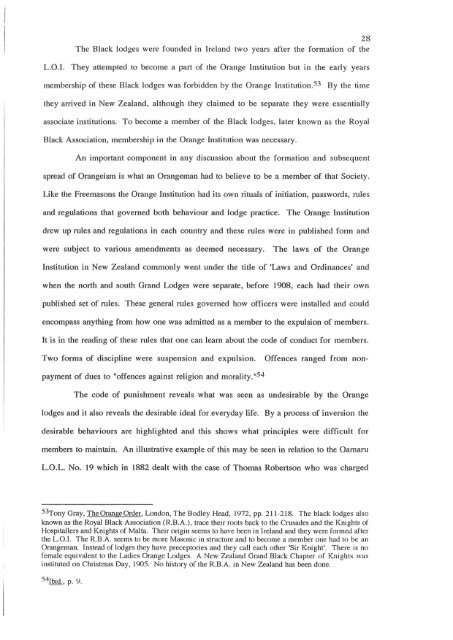TRANSPLANTED IRISH INSTITUTIONS - University of Canterbury
TRANSPLANTED IRISH INSTITUTIONS - University of Canterbury
TRANSPLANTED IRISH INSTITUTIONS - University of Canterbury
You also want an ePaper? Increase the reach of your titles
YUMPU automatically turns print PDFs into web optimized ePapers that Google loves.
28<br />
The Black lodges were founded in Ireland two years after the formation <strong>of</strong> the<br />
L.O.I. They attempted to become a part <strong>of</strong> the Orange Institution but in the early years<br />
membership <strong>of</strong> these Black lodges was forbidden by the Orange Institution. 53 By the time<br />
they arrived in New Zealand, although they claimed to be separate they were essentially<br />
associate institutions. To become a member <strong>of</strong> the Black lodges, later known as the Royal<br />
Black Association, membership in the Orange Institution was necessary.<br />
An important component in any discussion about the formation and subsequent<br />
spread <strong>of</strong> Orangeism is what an Orangeman had to believe to be a member <strong>of</strong> that Society.<br />
Like the Freemasons the Orange Institution had its own rituals <strong>of</strong> initiation, passwords, rules<br />
and regulations that governed both behaviour and lodge practice. The Orange Institution<br />
drew up rules and regulations in each country and these rules were in published form and<br />
were subject to various amendments as deemed necessary.<br />
The laws <strong>of</strong> the Orange<br />
Institution in New Zealand commonly went under the title <strong>of</strong> 'Laws and Ordinances' and<br />
when the north and south Grand Lodges were separate, before 1908, each had their own<br />
published set <strong>of</strong> rules. These general rules governed how <strong>of</strong>ficers were installed and could<br />
encompass anything from how one was admitted as a member to the expulsion <strong>of</strong> members.<br />
It is in the reading <strong>of</strong> these rules that one can learn about the code <strong>of</strong> conduct for members.<br />
Two forms <strong>of</strong> discipline were suspension and expulsion.<br />
Offences ranged from nonpayment<br />
<strong>of</strong> dues to "<strong>of</strong>fences against religion and morality. "54<br />
The code <strong>of</strong> punishment reveals what was seen as undesirable by the Orange<br />
lodges and it also reveals the desirable ideal for everyday life. By a process <strong>of</strong> inversion the<br />
desirable behaviours are highlighted and this shows what principles were difficult for<br />
members to maintain. An illustrative example <strong>of</strong> this may be seen in relation to the Oamaru<br />
L.O.L. No. 19 which in 1882 dealt with the case <strong>of</strong> Thomas Robertson who was charged<br />
s:ryony Gray, The Orange Order, London, The Bodley Head, 1972, pp. 211-218. The black lodges also<br />
known as the Royal Black Association (RB.A.), trace their roots back to the Crusades and the Knights <strong>of</strong><br />
Hospitallers and Knights <strong>of</strong> Malta. Their origin seems to have been in Ireland and they were fonned after<br />
the L.O.!. The RB.A. seems to be more Masonic in structure and to become a member one had to be an<br />
Orangeman. Instead <strong>of</strong> lodges they have preceptories and they call each other 'Sir Knight'. There is no<br />
female equivalent to the Ladies Orange Lodges. A New Zealand Grand Black Chapter <strong>of</strong> Knights was<br />
instituted on Christmas Day, 1905. No history <strong>of</strong> the RB.A. in New Zealand has been done.<br />
S4Ibid., p. 9.
















